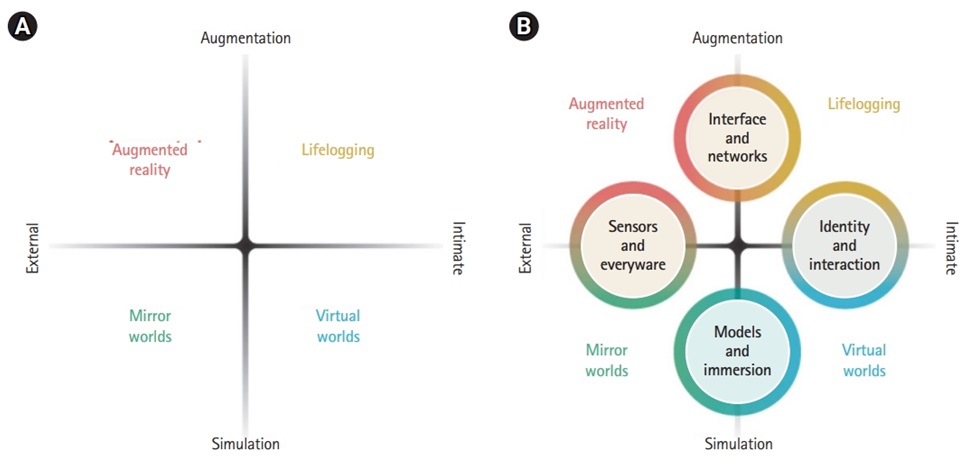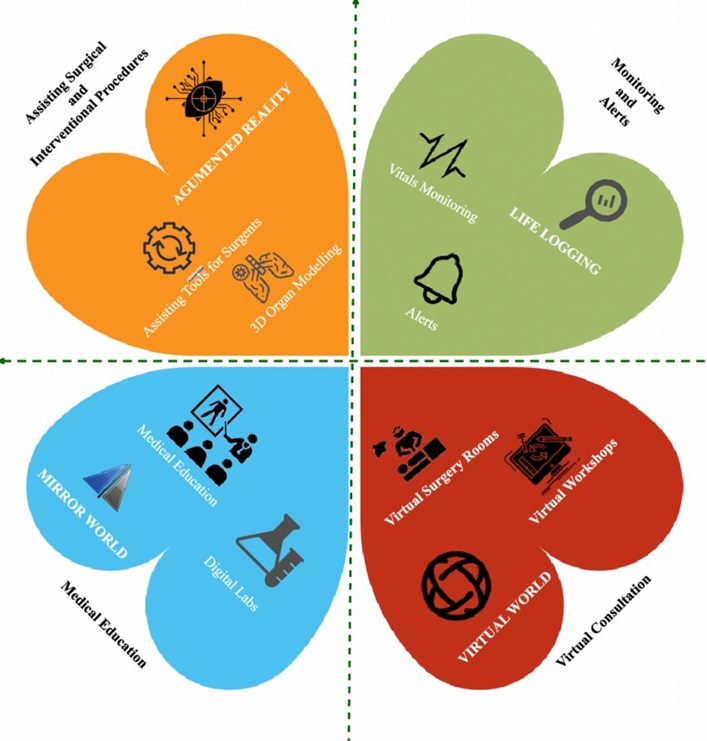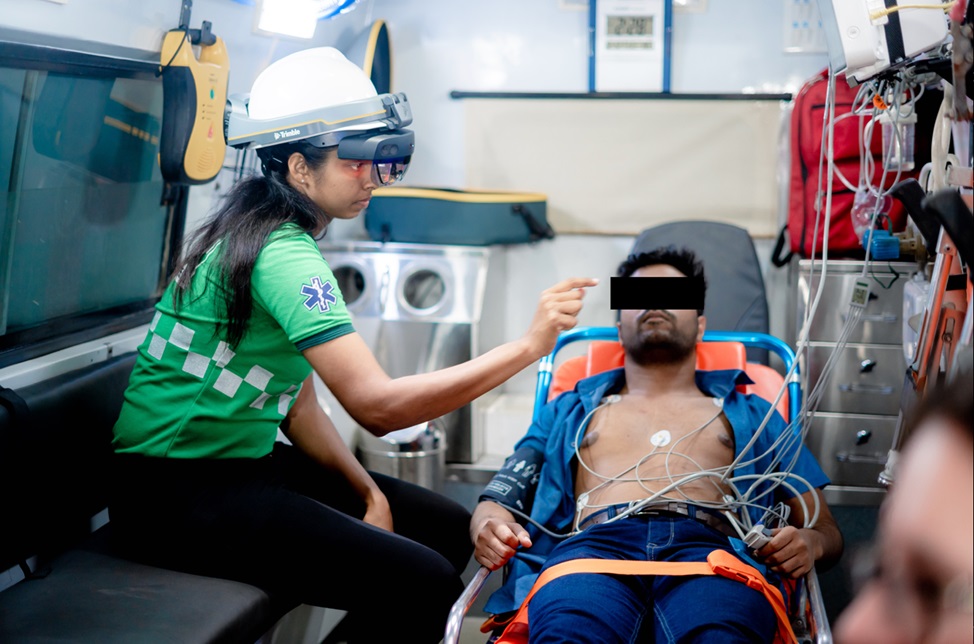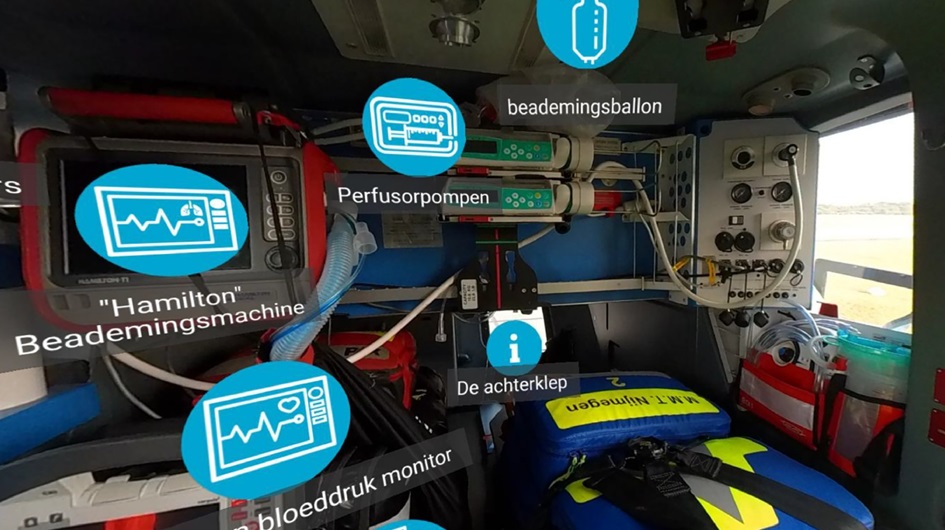Review Article-Metaverse: Some of its applications for trauma care in Sri Lanka

Abstract
Metaverse technology has significant potential for improving trauma care. Its core components are Augmented reality (AR), Virtual Reality (VR), lifelogging and Mirror worlds. Health 4.0 advancements presented by integration of AI (artificial intelligence) AR, VR and 5G networks will improve out comes for victims of trauma. However, adopting these technologies are not without challenges for low and middle income countries (LMIC) like Sri Lanka.
Article
Metaverse: Some of its applications to trauma care in Sri Lanka
Indika Jagoda, Melanie Amarasooriya
DOI: https://doi.org/10.62474/SLJT-EJLX5117
Introduction
Metaverse is a concept introduced three decades ago which simply means a shared real and virtual world or a universe. It refers to a virtual reality existing beyond the true reality. The science-fiction author Neal Stephenson coined the term metaverse in his novel “Snow Crash” published in 1992 (1). According to some broader definitions, the metaverse represents a futuristic virtual world in three-dimensions (2). Since its beginning, the metaverse concepts have been applied in various industries such as education, entertainment, manufacturing, finance and also in healthcare.
With regard to healthcare, metaverse technology has been used in many aspects such as remote patient management using immersive technologies there by reducing costs, improving accessibility and there by promoting universal health coverage (3). In training and education virtual reality (VR)and augmented reality (AR) play a crucial part in developing training modules (4, 5). Creating ‘digital twins’ (virtual replicas of patients) enables predictive healthcare (6).
Trauma care represents a complex interaction between humans and technology. Historically advancement in trauma care is linked to advancement in technology. With the increasing population demands metaverse has unique applications in enhancing trauma care. Virtually supporting the frontline workers in healthcare, by experts, training in simulated environments are applications. Situations like war front without enough access to senior emergency care professional at the frontline are challenging and potentially can be supported by metaverse technology (7).
Metaverse, definitions and the roadmaps
Metaverse is recognized as convergence of Augmented Reality (AR) and Virtual Reality (VR), as its core the concepts. The Acceleration Studies Foundation (ASF), a representative metaverse research organization announced the metaverse roadmap in 2006 (Reference) and defined ‘Augmented reality’, ‘Virtual worlds’, ‘lifelogging’ and ‘Mirror worlds’ as four types of metaverse. In the ASF roadmap, two axes were presented to explain these four types of the metaverse. One is ‘augmentation versus simulation’, and the other is ‘intimate versus external’ (Figure 1) (2, 8).

Figure 1 The two axes and the four types of metaverse. Reproduced from Kye B, Han N, Kim E, Park Y, Jo S. Educational applications of metaverse: possibilities and limitations. J Educ Eval Health Prof. Reproduced under the terms of the Creative Commons Attribution License
Augmentation vs simulation: The first axis is augmentation versus simulation. Augmentation technology enhances human sensing or adds new functions to a real-world environment through stimuli. Simulation models the reality.
Intimate vs external: The second axis is intimate versus external. The intimate metaverse focuses on personal behavior and individual data. The external metaverse focuses on the surrounding world (2, 9, 10).
Thus, the four types of metaverse can be defined using the two axes. ‘Augmented reality’ lies in the interphase between augmentation and external environment; Virtual worlds can be intimate and simulated; Lifelogging is likely to be augmented and intimate; Simulated external environments are the mirror worlds.
Augmented reality (AR):
Augmented Reality (AR) refers to a virtual three-dimensional (3D) version of reality world over which external information is transformed to computer-generated virtual information. Users experience the real-time interactive experience between real world and virtual world. In general, users have employed glasses, lenses, smartphone, and computers, with the typical examples of AR stereoscopic images and 3D construction. This technology is used in assisting surgical and interventional procedures (11, 12).
Virtual reality (VR):
Virtual reality has been recognized as a completely virtual 3D world. In this, individual information is superimposed on 3D computer generated environments that users are enabled to immerse themselves in for interaction and exploration. Users register a virtual personalization avatar in the virtual world for activation and communication. The specific examples cover virtual reality training program and virtual hospitals (13). Virtual reality can be used for trauma and surgical training.
Lifelogging:
Lifelogging refers to a record-keeping platform where users can record their real individual information using a virtual format to share with others, with typical examples of Instagram, Facebook, X (formerly Twitter), and health monitors (14)
Mirror worlds
Mirror world (e.g., Zoom meeting, BizConf Video, and 360-degree video) is a virtual world that is replicated in accordance with real external events to create a repeated environmental experience for users (15).
Metaverse and its applications in healthcare
The four types of metaverse as applicable for health care are presented in the table 1 and figure 2.
Table 1; Types of metaverse and their application in healthcare
| Type of metaverse | Application in healthcare |
| Augmented reality | Assisting surgical and interventional procedures |
| Virtual reality | Virtual consultations and surgical training |
| Mirror worlds | Medical education |
| Lifelogging | Monitoring and alerts |

Figure 2: Four types of metaverse and their applications. Reproduced from Metaverse for Healthcare: A Survey on Potential Applications, Challenges and Future Directions.” By “Chengoden et al. (2022). Reproduced under the terms of the Creative Commons Attribution License.
Metaverse –its applications for trauma care in Sri Lanka
Trauma care in the platinum ten minutes and golden hour
There is ample evidence that prompt attention by well-trained trauma care professionals increase the positive patient outcomes following trauma (16, 17). However, there are many challenges bringing the patients to the attention to trauma care experts within the golden hour (18). The challenges may range from simply geographical, or situation related as in mass disasters where access is limited to unavailability of human resources in ideal levels. In such challenging situations metaverse technologies may enable remote assistance. The first contact persons can be equipped with AR eyewear can connect with trauma surgeons based in a trauma center. The other experts can also join to provide guidance and support at the initial stages. Quick and seamless flow of information in real-time and expertise will improve the outcomes. In addition, there is evidence that trauma surgery outcomes can be improved using AR technology to visualize medical imaging (19).
Currently Sri Lanka’s prehospital ambulance service “Suwasariya” started using Internet of Medical Things (IoMT) and Microsoft HoloLens® AR features, to connect emergency medical team personal with experts remotely (Figure 3). The aim was to enhance patient care during the golden hour of medical emergencies by early attention of medical experts.

Figure 3 : Suwasariya Emergency Medical Technician (EMT) using VR technologies. Image courtesy Mr Sohan De Silva, Chief Executive Officer of Suwasariya
Trauma Training
One of the key applications of Metaverse technologies in trauma care is for training of healthcare personnel. In Trauma care, opportunities to learn from attending to real patients are limited. The trauma situations need the care from the most experienced professionals available. Real trauma situations can hardly be used for hands on training. In addition, there is minimal time for formal teaching while managing victims of trauma. But practical experience for healthcare professional is of utmost importance.
Metaverse and other immersive technologies like Virtual reality (VR) and Augmented reality (AR) technologies could be used to simulate various trauma scenarios, diagnose conditions, and practice critical interventions and surgical techniques in a risk-free environment. Among the 4 types of the metaverse, the most diverse and actively used technology in education is virtual reality (1). It allows leaners to improve their skills and knowledge to a level which cannot be offers by traditional teaching and training methods, help to understand complex concepts, and can be used as a way of assessing trauma management and decision-making abilities. (1,3)
Holla M et al. states that in a systematic review in 2021 the majority suggested that VR based head mounted devices have beneficial effects for medical education. Another systematic review in 2022 reported that participants highly appreciated using VR than most other training methods. VR outperformed traditional methods of learning surgical procedures (20). These technologies offer immersive learning for trauma care.
Authors Hella et.al describes how VR technologies used for simulation of extrication of trauma patient by helicopter team by using 360° camera and special 3D software which creates clickable labels inside the VR space (Figure 4). Using VR, participants were able to experience prehospital trauma care, at a level that was impossible without VR.

Figure 4; VR technologies used for simulation of extrication of trauma patient by helicopter team by using 360° camera and special 3D software. From Virtual Reality Techniques for Trauma education by Holla, M., & Van Den Berg, M. (2022). Injury. Reproduced under the terms of the Creative Commons Attribution License.
Telemedicine and remote medicine
Telemedicine, the provision of remote medical services, has experienced a significant acceptance since the COVID -19 pandemic. It popularizes and increase the use of telephone or video consultations. Metaverse platforms and applications can add an immersive experience for this, particularly through VR headsets, creating a sense of presence unmatched by traditional online channels. This allows patients to virtually meet clinicians. This will be useful in provision of care to remote and rural settings, for people with mobility issues and in disaster situations.
Facilitating digital health economy
Metaverse technologies enables patients to meet global experts and experts will be able to provide their services to a global client. Robotic surgical systems are allowing surgical operations to be performed even the surgeon and the patient are at two distant locations. Facilitating scans and tests at local facilities, with results easily shared with specialists globally and vice versa will improve accessibility a. financial transactions n associated with these will facilitate development of digital health economy. Development of AI based algorithms for image recognition etc. and the associated intellectual property rights will open up a new avenue in income generation and they may be future commercial determinants of health.
While metaverse technology has many advantages, it is not without challenges such as ethical and medico legal concerns (21, 22).The initial cost for devices is one such concern. But with the advancement of technology and manufacturing techniques the costs have come down. While these applications can have an initial cost, they are still useful in developing countries such as Sri Lanka, where trained human resources for trauma care are lacking. It may also be cost effective to provide remote services from established trauma centers to a certain extent to the rural areas, rather than transferring patients. However, these need careful technology assessment and this an area where expertise needs to be developed in Sri Lanka. In addition, training personnel to use new technology, establishing alternatives in system failures also need to be addressed. These present significant challenges to health management. Maintaining privacy, confidentiality of data and data security, ethical concerns, and safety during incorporation of technology for trauma care is of utmost importance.
Metaverse is here to stay, and it will change the way we care for trauma.
Acknowledgments: None
CRediT statement : Both authors contributed equally
Funding : None
Competing interests: None declared.
Patient consent for publication: Not applicable.
Ethics approval this study : Not applicable
Data availability statement: Images are not available for patient confidentiality.
Supplemental material: None
Open access ; This is an open access article distributed in accordance with the Creative Commons Attribution Non Commercial (CC BY-NC 4.0) license. See: http://creativecommons.org/licenses/by-nc/4.0/.
Artificial intelligence: Generative artificial intelligence or artificial intelligence assisted technologies were not used in preparation of this article
ORCiD
Melanie Amarasooriya https://orcid.org/0000-0002-5629-543X
Indika Jagoda https://orcid.org/0009-0008-1985-1661
How to Cite this article;
Jagoda, A. I., & Amarasooriya, M. (2024). Metaverse; some of its applications for trauma care in Sri Lanka. Sri Lanka Journal of Trauma, 1(1). https://doi.org/10.62474/SLJT-EJLX5117